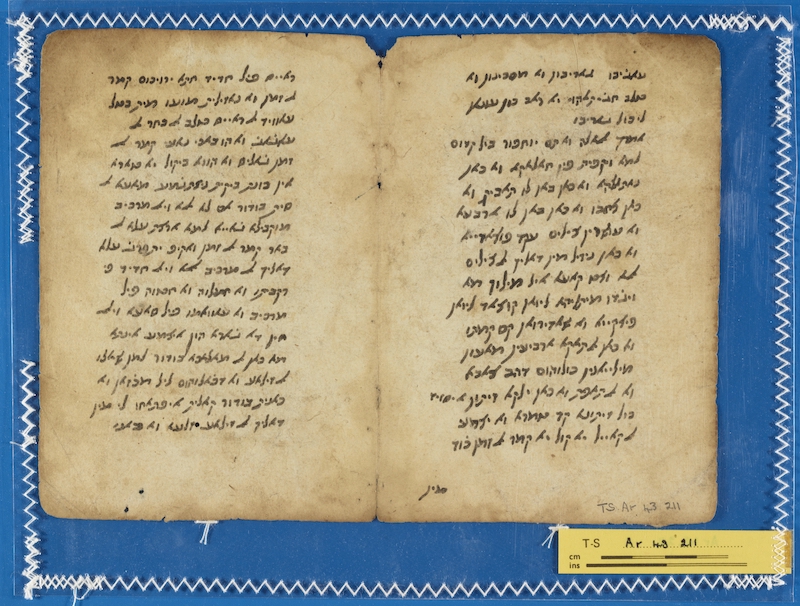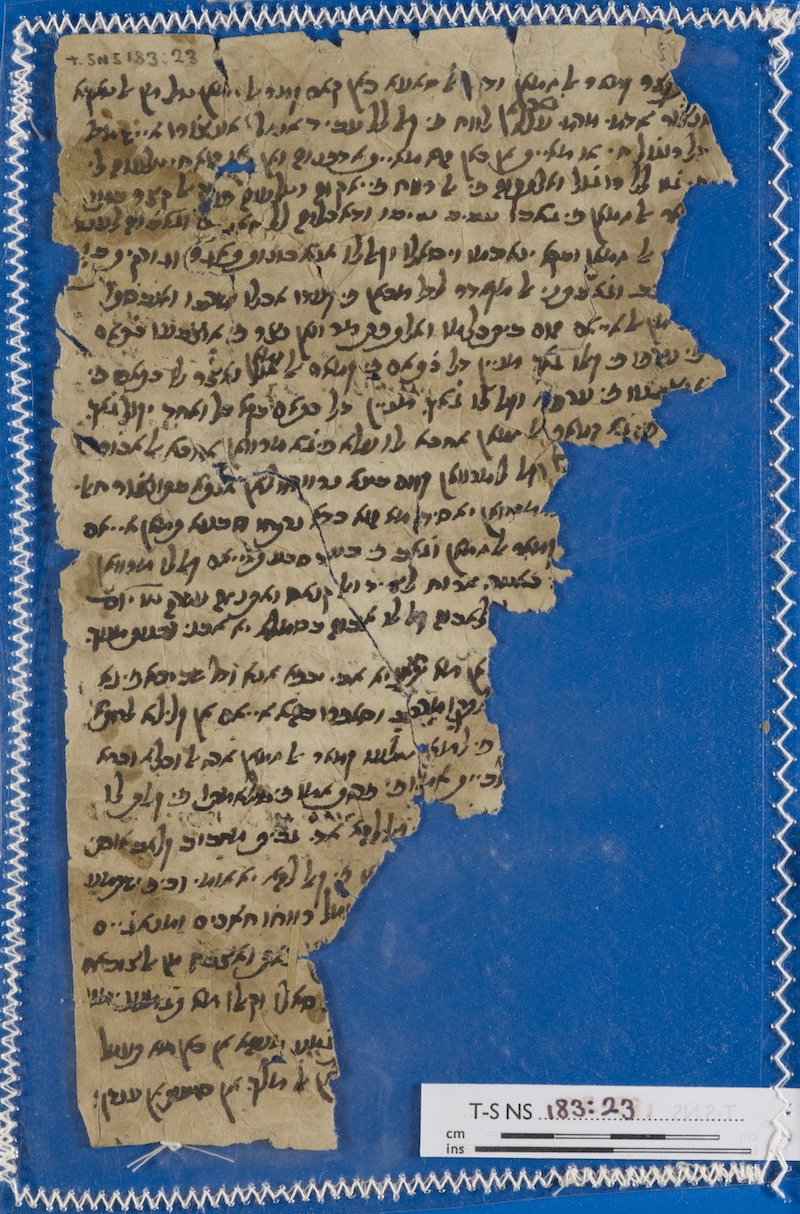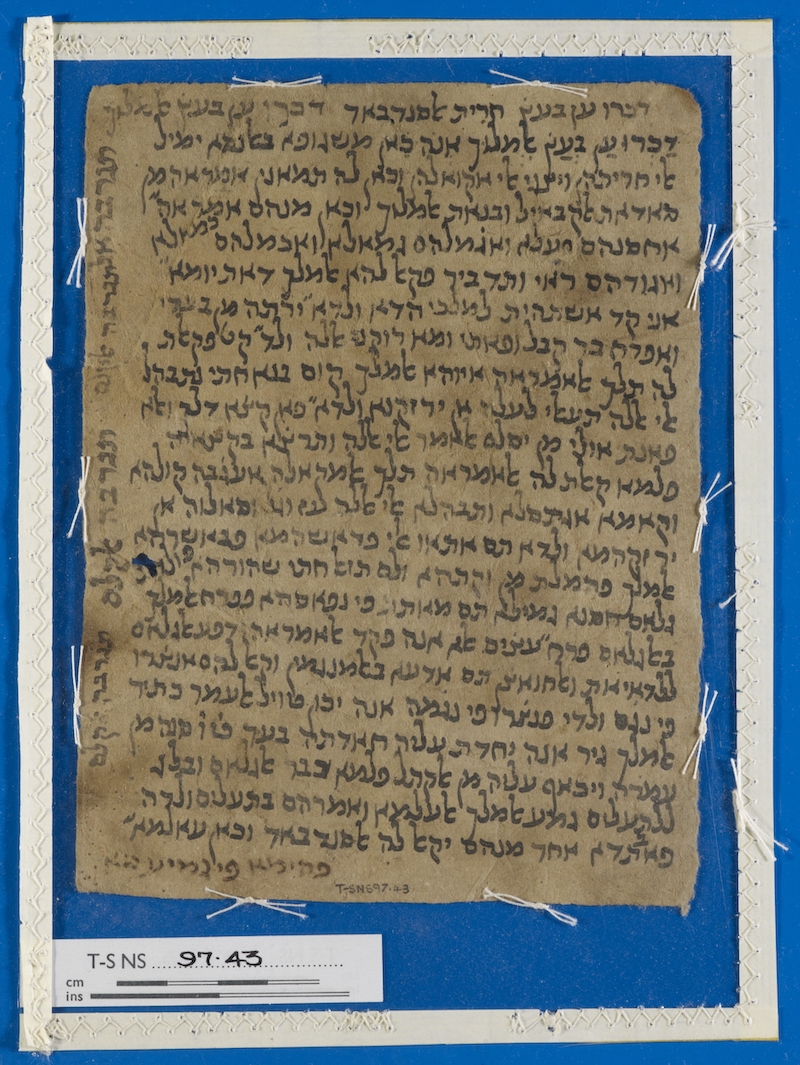The Judaeo-Arabic manuscripts of the ‘Arabian Nights’ found in the Cairo Genizot: T-S NS 183.18+23+35+37+38
The first discovery of the title - Alf Layla wa-Layla - written in Judaeo-Arabic was by S.D. Goitein. It is a twelfth-century Genizah document in which an anonymous Jewish bookseller wrote that he had sold a manuscript of Alf Layla wa-Layla.1 The earliest Genizah manuscript that contains passages from the ‘Arabian Nights’ in Judaeo-Arabic script is dated to the thirteenth century, and the latest Genizah text of the ‘Arabian Nights’ written in Judaeo-Arabic can be ascribed to the eighteenth century. After scanning a substantial part of the Genizah collections, forty items of the ‘Arabian Nights’ were located, of which twenty-one are from the Firkovitch collection (a Genizah collection that originated in the Karaite synagogue in Egypt, Dār Simḥa) and the rest are from the so-called Genizah (the manuscripts kept in the Rabbanite Ibn Ezra synagogue in Fustat).
The traditional transmission of the authentic Arabic manuscripts of the anthology begins with the Syrian manuscript that was the basis for the French translation by Antoine Gland (= ‘Gland's MS’). This is the earliest Arabic manuscript found to date (from the 14th or 15th centuries), and it includes only 282 nights, what is commonly referred to as the ‘core stories’ of the corpus. This is in fact the only manuscript that has so far won a completely faithful edition of the original. None of the other Arabic editions of ‘A Thousand and One Nights’ correlate to the manuscripts that underlie them, the editors adding different stories that they collected in different ways or alternatively omitting parts of the manuscripts.
The first source of the Arabic anthology was probably the Persian collection ‘Hazār afsāna’ (= ‘A Thousand Stories’), but it is known that many other cultures also contributed to the final configuration of the Arabic ‘Thousand and One Nights’ versions, among them: Indian, Baghdadi and Cairene. ‘A Thousand and One Nights’ in Arabic was a variable corpus that grew during the Middle Ages and the early modern period. Some of the ‘Thousand and One Nights’ stories have roots in ancient Arabic literature (geographical, historical, etc.), others circulated (being delivered orally or copied) in the Middle Ages in popular editions unrelated to the title ‘Thousand and One Nights’. For this reason, any discussion of the anthology should be done with sufficient caution, taking into account this background.
An example showing this complexity of determining if a tale can be regarded as the ‘Arabian Night’ or not is the tale of ‘The King, His Son, His Concubine and the Seven Viziers’ (known also as ‘The Craft and Malice of Women’) found in a few Judaeo-Arabic manuscripts from the Genizah, the earliest one of which is dated to the eleventh (!) century,2 this is - OX Heb. d. 36.3–8. The manuscript consists of seven folios and is written on parchment. On the one hand the texts can be regarded as ‘Arabian Nights’ since the story was included in late versions of the anthology. On the other hand, the text originates in the Sindbad-name (‘The Book of Sindbad’) known from before the eight century and based on Indian and Persian tales. The book has Syriac, Greek (eleventh century) and Hebrew versions (‘Mishle Sindabar’, known before the thirteenth century),3 which should cause us to classify the text as Arabic or Hebrew versions of ‘The Book of Sindbad’, rather than the ‘Arabian Nights’, even in light of the fact that the story was included in the ‘Arabian Nights’ in later recensions of the anthology.4 However, it is important to note that early versions of the ‘Arabian Nights’ tales circulated among Arabic-speaking societies of the Middle Ages, and at some point were adapted by editors and collectors and included in their recension of the famous anthology.

T-S Ar.43.211, recto, part of the tale of Qamar al-Zamān
The Judaeo-Arabic Genizot manuscripts contain the following stories of the ‘Arabian Nights’5: ‘The Fisherman and the Jinn’, ‘Masrūr the Merchant and Zayn al-Mawāṣif’, ‘ʿAlī Nūr al-Dīn and Maryam the Girdle-Girl’, ‘Uns al-Wujūd and al-Ward fi al-Akmām’, ‘The City of Brass’, ‘Qamar al-Zamān’, ‘Tale of ʿOmar b. al-Nuʿumān and his Sons’, ‘Nūr al-Dīn ʿAlī and the Damsel Anīs al-Jalīs’, ‘The Hunchback’s Tale’, ‘Ḥassan the Jeweller’, ‘Sayf al-Mulūk’, ‘King Badr’, ‘The Slave-girl Tawaddud’, ‘The story of ʿAlāʾ al-Dīn Abu al-Shāmāt’ ‘The Tale of Hārūn al-Rashīd wal-Barāmika’, ‘The Tale of Aḥmad al-Danaf wa-Ḥasan Shūmān’, ‘The King His Son, His Concubine and the Seven Viziers’ (mentioned above); ‘The Linguist Dame’, ‘Iṣḥāq of Mosul, his Mistress and the Devil’.6 None of the tales found is complete. (The Genizah also contains a few manuscripts of the ‘Arabian Nights’ written in Arabic letters.7 This material is beyond the scope of this article.)

T-S NS 183.23, recto, another manuscipt of the tale of Qamar al-Zamān
As the majority of the manuscripts are fragmentary, we cannot determine if the stories were parts from a large number of copies of the entire anthology or whether the tales were copied independently, i.e. were copied separately from the whole anthology and stood as individual tales. The majority of the manuscripts include only a few papers and lack numbering of the nights (like T-S Ar. 43.211 or T-S NS 183.18+23+35+37+38 – ‘The tale of Qamar al-Zamān’), which make the conclusions in this matter only a speculation. However, a few manuscripts include a numbering of the nights in them, indicating that the anthology was formed as a collection of tales at the time the manuscripts were copied; these manuscripts are late, dating from not before the sixteenth-seventeenth century (for example: T-S Ar. 36.68 - ‘Sayf al-Mulūk’). Manuscript T-S NS 97.43 includes the beginning of the story of Sindbad and contains the title חדית סנדבאד (= ‘The Tale of Sindbad’) in its first page, what indicates that this copy of the tale stood separately from the anthology of the ‘Arabian Nights’.

T-S NS 97.43, recto, contains the title ‘The Tale of Sinbad’
The story of ‘The Fisherman and the Fish’ (included in the so called ‘core stories’) appears in the greatest number of manuscripts (6). The earliest of which is apparently from the fourteenth century, that is, it was copied at the same time or even earlier than Galland’s MS. In some manuscripts of the ‘Arabian Nights’ the number of the nights is mentioned, indicating that the anthology was copied entirely. Other manuscripts present just separate tales.
Fitting the nature of popular literature, the texts contain different versions from those included in the Arabic printed editions. While some versions are “close” (but never similar!) to individual Arabic recensions of the anthology, others are unique. Some of the versions can be regarded as ‘Jewish versions’: one example is a Judaeo-Arabic manuscript of the ‘The story of ʿAlāʾ al-Dīn Abu al-Shāmāt’ in which a Jewish character who is absent from the Arabic versions is mentioned in the Judaeo-Arabic version in a very positive way. Both Judaeo-Arabic versions mentioned above of the story of ‘The Fisherman and the Fish’8 and ‘the ‘The story of ʿAlāʾ al-Dīn Abu al-Shāmāt’9 depict not only unknown versions but also more coherent (!) versions than the Arabic versions known to date.
The Genizot also include stories that can be regarded as “Arabian Nights-like stories”, i.e. stories that assimilate in their literary style and themes to the stories of the ‘Arabian Nights’, but which were not included in any of its recensions,10 for instance a charming and unknown story that depicts an anthology on the figure of ʿAlī the swindler of the daytime (al-ʿāʾiq ʿAlī Shāṭir al-nahār) and ʿAlī the swindler of the night (al-ʿāʾiq ʿAlī Shāṭir al-layl).11 The text contains episodes about the misdeeds of the two swindlers, is told by al-rāwī and contains segments of poetry. One section of poetry found in the text is similar to a poetry segment found in ‘The Story of Jānshāh’ from the ‘Arabian Nights’.12 The shenanigans of the two ʿAlīs are also very reminiscent of ʿAlī Zeybaq’s episodes from the ‘Arabian Nights’. Another example is ‘The Story of Zayd and Kaḥlāʾ’ which is a Maghāzī story that depicts a love story between Zayd and his lover Kaḥlāʾ at the time of the prophet Muhammad. The story is found in two Judaeo-Arabic manuscripts from the Genizot and very similar, in terms of style and literary motifs, to the episodes includes in the ‘Arabian Nights’.
To conclude: the Judaeo-Arabic material of the ‘Arabian Nights’ found in the Cairo Genizot raises important questions concerning both the Arabic-Muslim recensions of these texts and also concerning the involvement of Jewish circulation of the adapted tales. The material is of great significance for the study of the complex formation of the famous anthology and of real interest for understanding Jewish involvement in it.13
Footnotes
1 S. D. Goitein. “The Oldest Documentary Evidence of the Title Alf Layla wa-Layla,” J.A.O.S. 78 (1958): 301–302. [For the earliest Arabic fragment see N. Abbott, “A Ninth-Century Fragment of the ‘Thousand Nights’: New Lights on the Early History of the Arabian Nights.” Journal of Near Eastern Studies 8 (1949): 129–164.]
2 I thank Dr. Amir Ashur for dating this manuscript for me.
3 M. Mahdi. Alf Layla wa-Layla. 3 vols. Leiden 1984. Vol. 3, pp. 154–155.
4 The Arabian Nights Encyclopedia. U. Marzolph and R. van Leeuwen (eds.), 2 vols. Santa Barbara – Denver – Oxford, 2004. pp. 1160– 161, 703– 704.
5 The first to identify Judaeo-Arabic material of the ‘Arabian Nights’ in the Cairo Genizot was Victor Lebedev. See: “New Material on the History of Jewish-Arabic Literary Relations in the Middle Ages.” Proceedings of the Eleventh World Congress of Jewish Studies. Jerusalem 1994, vol. 1, pp. 33–39; “Cats, Mice, Thieves and Heroes in ‘Arabian Nights’ Geniza Tales.” Genizah Fragments 24 (1992): 2; “Unsearched Sources of Yemenite Arabic.” Studia Orientalia 67 (1991): 51–54. Other manuscripts were identified by the current author and can be located through the Friedberg Genizah project, online site. See also the next footnote.
6 For identification and discussion of the last two tales see: O. Zinger. “Meanderings in the Arabic Literary Genizot.” Intellectual History of The Islamicate World 8 (2020): 188–223.
7 See for instance: T-S Ar. 40.164, T-S Ar. 40.71 and T-S Ar. 40.28 which are parts from the same copy of the tale هارون الرشيد والبرامكة.
8 See: M. Salje. “Njezrjestnjij variant “skazni o rjibakje I duxje’ iz 1001 notcn” (= “Unknown version of ‘The Fisherman and the Genie’ from ‘One Thousand and One Nights’”), Zapiski Kollegii Vostokovedov pri Aziatskom muzee Akademii nauk Soiuza Sovetskikh Sotsialisticheskikh Respublik 5. Leningrad 1930. pp. 405 – 428.
9 See: Hasson Kenat, New Manuscripts Written in Late Judaeo-Arabic from the Firkovitch Collection – Description, Classification and Sample Texts. PhD Dissertation. The Hebrew University of Jerusalem 2016. pp. 213–217.
10 See for example: J. Sadan. “Examen de données extra-textualles en arriére-plan de certains contes des Mille et une nuits” in A. Chraibi and C. Ramirez (eds.) Les Mille et une nuits et le récit oriental: En Espagne et en Occident. Paris 2009. pp. 75-92.
11 The text is found in six Judaeo-Arabic manuscripts: MSS RNL Yevr.-Arab. II:176, RNL Yevr.-Arab. II:270, T-S Ar. 6.23 and ENA 3476.4 belong together, T-S Ar. 6.24 and OX Heb. f105.47–50 belong together. For a discussion and critical edition of the text see: R. Hasson. “’The story of al- Shāṭir ʿAlī’ – a popular story written in late Judaeo-Arabic from the Genizah.” In M. Frenkel and P. Lieberman (eds.), Festschrift for Professor Joshua Blau, Leiden-Jerusalem 2021. [Hebrew. Accepted]. For a different Egyptian version of the story see: Wilhelm Spitta-Bey. Grammatik des arabischen Vulgärdialectes von Aegypten. Leipzig 1880, pp. 456–461.
12 See for instance: Bulaq edition (1836),1, pp. 282–283.
13 The Judaeo-Arabic manuscripts of the ‘Arabian Nights’ found in the Genizot are intended to be published by the author of this article. This study is a part of her broader work on Judaeo-Arabic popular literature found in the Genizot during the last twenty years.
Cite this article
Hasson, R. (2021). The Judaeo-Arabic manuscripts of the ‘Arabian Nights’ found in the Cairo Genizot: T-S NS 183.18+23+35+37+38. [Genizah Research Unit, Fragment of the Month, September 2021]. https://doi.org/10.17863/CAM.82605
If you enjoyed this Fragment of the Month, you can find others here.
Contact us: genizah@lib.cam.ac.uk
The manuscripts in this article are part of the Cairo Genizah Collection in Cambridge University Library. To see more items from this collection visit: https://cudl.lib.cam.ac.uk/
